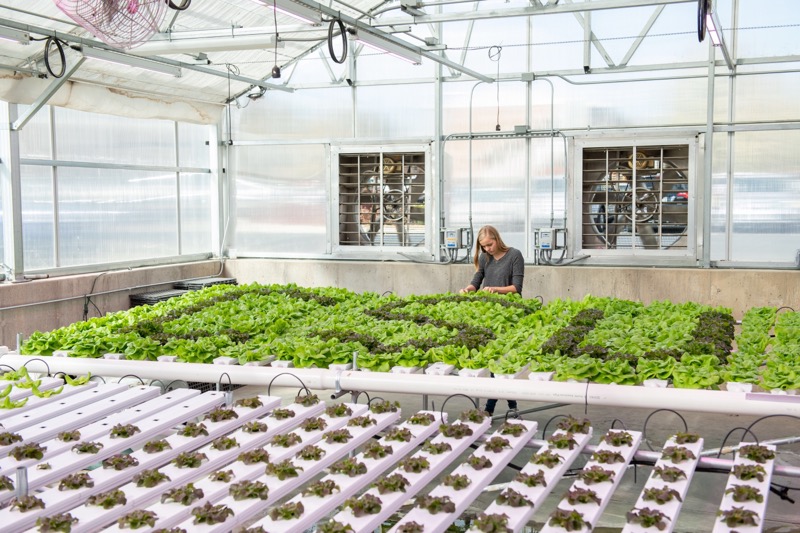
Students who eat in the dining centers on the Colorado State University campus may have experienced a shift in their salads without even knowing it.
In 2016, the CSU Horticulture Center struck a partnership with Housing & Dining Services to provide hydroponically grown lettuce to the dining centers. The lettuce-growing operation in the Horticulture Center has grown into a devoted team of individuals known as the Campus-Grown Food Partnership. The goal is to aid in incorporating perspectives on sustainable foods and give students hands-on learning opportunities in one of the campus’s living labs.
Kirstie Tedrick, sustainability coordinator for HDS, chairs the partnership. As a graduate of the Warner College of Natural Resources, Tedrick was the sustainability intern and graduate assistant for the President’s Sustainability Commission at CSU.
“While it encompasses the environmental side of preserving resources for our future generations, there is also social and economic accountability to sustainability,” she says.
Horticulture Center lettuce is used in the salad bar in The Foundry at Corbett Hall and in the express centers for “grab-and-go” items as well as at special events such as the President’s Fall Address and University Picnic, and Environmental Eats. The partnership also assists with other campus-grown foods such as the microgreen cabinets at The Foundry, Braiden Hall, and the Tower Garden at Aggie Village Apartments.
“Environmental Eats recognizes that you don’t have to be fully vegan or vegetarian to be sustainable, it’s just a matter of knowing where your food comes from and its impact on the environment,” Tedrick explains.
Connecting to local food
Royce Lahman, meal access coordinator for Residential Dining Services, was a part of the inaugural partnership to provide dining halls with campus-grown lettuce. Lahman graduated from the Department of Horticulture and Landscape Architecture in 2012.
“Early in my degree, I was drawn to connecting a local food source to our on-campus dining facilities,” said Lahman. “In working in the dining centers as a student, I was able to see the various sources for food products that often originated outside of our local area. Creating a sustainable and local program to source food products was a great avenue to connect my studies to my place of work.”
Today, the lettuce production is spearheaded by horticulture intern Abby Lathrop-Melting, an undergraduate majoring in biology with a minor in horticulture.
“For me, the main thing is to see greens that I grew in the dining hall,” says Lathrop-Melting. “That relationship with your food is super valuable. I was most intrigued to see how much of an impact it has on the dining halls. Because I’m a student, it’s valuable to get hands-on experience with a sustainable food system, to be able to break it down and understand how each individual part affects the other.”
Lathrop-Melting is also delving into new hydroponic projects such as tomatoes, cilantro, chervil and dill.
Hydroponics practicum
Beginning in Spring 2019, a new course grew out of the Campus-Grown Food Partnership, a hydroponics practicum offered to upper-level horticulture students. Within this course, students are assigned a hydroponic grow table and are responsible for planting, growing, harvesting and cleaning lettuce for the entirety of the semester. This course is funded by student fees, enrollment costs, and the HDS Sustainability Fund, which provided the course with monitoring equipment.
From planting to plating, this collaboration has a lot of moving parts, and campus-grown food could not exist without the joint efforts of everyone involved – from students in the practicum to the chefs curating recipes from the greens and herbs grown in the course.
Jeremy Morgan, the executive chef of HDS, understands the benefits that campus-grown food brings to the table.
“I think locally sourced ingredients are great, because using them helps support local economies, provide unrivaled freshness, and is ultimately more environmentally friendly because fewer resources are needed for transport,” said Morgan. “Campus-grown food also allows our dining centers to serve the freshest greens and herbs available.”
The Campus-Grown Food Partnership team is continually looking for ways to incorporate new grassroots efforts to expand campus-grown food and educational opportunities to engage students, while perfecting the lettuce provided to the dining centers.